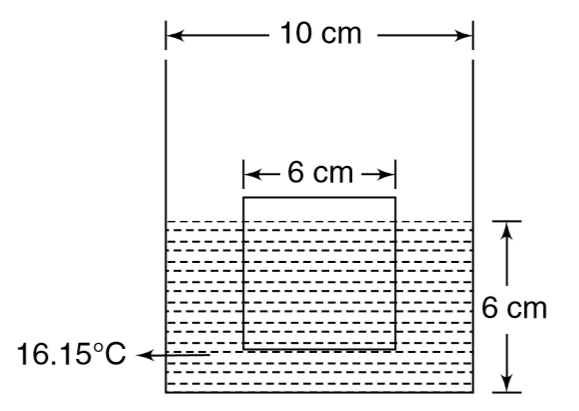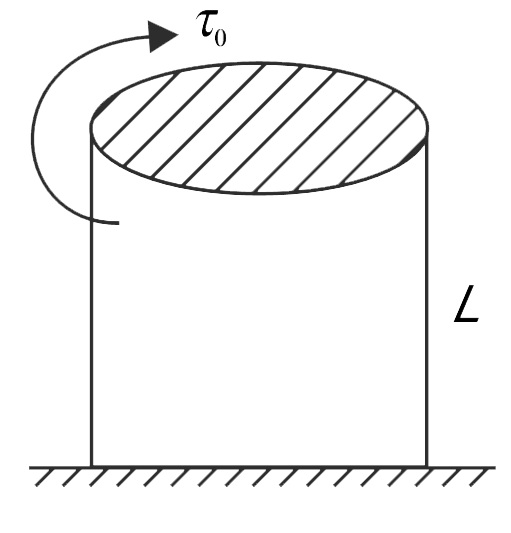A calorimeter of negligible heat capacity contains ice at 0∘C. 50 g metal at 100∘C is dropped in the calorimeter. When thermal equilibrium is attained the volume of the content of the calorimeter was found to reduce by 0.5×10−6m3. Calculate the specific heat capacity of the metal. Neglect the change in volume of the metal. Specific latent heat of fusion of ice is L=300×103Jkg−1 and its relative density is 0.9.
The correct Answer is:270Jkg−1k−1
Step by step video, text & image solution for A calorimeter of negligible heat capacity contains ice at 0^(@)C. 50 g metal at 100^(@)C is dropped in the calorimeter. When thermal equilibrium is attained the volume of the content of the calorimeter was found to reduce by 0.5 xx 10^(-6) m^(3). Calculate the specific heat capacity of the metal. Neglect the change in volume of the metal. Specific latent heat of fusion of ice is L = 300 xx 10^(3) J kg^(-1) and its relative density is 0.9. by Physics experts to help you in doubts & scoring excellent marks in Class 11 exams.
Topper's Solved these Questions
Similar Questions
A container has a square cross-section of 10cm×10cm. A cubical ice block of side length 6 cm is floating in water in the container. Water level in the container is 6 cm high. The ice block is at a temperature of 0∘C and the water is at 16.15∘C. Assume that heat exchange take place between the ice block and water only. What length of ice block will remain submerged in water when the system reaches thermal equilibrium? Assume that the ice block maintains its cubical shape as it melts. Take - density of ice =0.9g/cc, density of water = 1.0g/cc
Specific heat capacity of water =1calg−1.∘C−1, Specific latent heat of fusion of ice =80calg−1
 02:57View Solution
02:57View SolutionA copper calorimeter has mass of 180 g and contains 450 g of water and 50 g of ice, all at 0∘C. Dry steam is passed into the calorimeter until a certain temperature (θ) is reached. The mass of the calorimeter and its contents at the end of the experiment increased by 25 g. Assume no heat loss to the surrounding and take specific heat capacities of water and copper to be 4200Jkg−1K−1 and 390Jkg−1K−1, respectively. Take specific latent heat of vaporization of water to be 3.36×105Jkg−1 and 2.26×106Jkg−1 respectively.
(a) Find the final temperature θ
(b) If steam enters into the system at a steady rate of 5g−1min, plot the variation of temperature of the system till final temperature θ is attained.03:18View SolutionIn an experiment mileage of a car was measured to be 24kmpl (Kilometer per liter of fuel consumed). After the experiment it was found that 4% of the fuel used during the experiment was leaked through a small hole in the tank. Calculate the actual mileage of the car after the tank was repaired.
02:50View SolutionA metal cylinder of length L and radius R is fixed rigidly to ground with its axis vertical. A twisting torque τ0 is applied along the circumference at the top of the cylinder. This causes an angular twist of θ0 (rad) in the top surface. Calculate the shear modulus of elasticity (η) of the material of the cylinder.
 View Solution
View Solution10 gm of ice at -20^(@)C is dropped into a calorimeter containing 10 gm of water at 10^(@)C , the specific heat of water is twice that of ice. When equilibrium is reached the calorimeter will contain:
06:26View SolutionWhen 45g of a metal at 100∘C is dropped into an ice calorimeter, the contraction in the volume of the ice is observed ot be 0.4596×10−6m3. What is the specific heat capacity of the metal? (L=336×103Jkg−1 and relative density of ice =0.917)
03:14View Solution1kg of ice at 0∘C contracts by 91x10−6m3 on melting. A solid weighitn 40g and at 60∘C dropped into an ice calorimeter cause a change in volume of 0273×10−6m3.
(Specific latent heat of fusion of ice =336×103Jkg−1. Calculate the specific heat capacity of the solid.09:06View SolutionA copper calorimeter of mass 100 g contians 200 g of ice at -10^(@)C . The thermal energy is upplied to the calorimeter and its contents at the rate of 50 calories per second. What is temperature of the calorimeter and its contents after ten minutes. (Given, the specific heat of ice =0.5 cal g^(-1)""^(@)C^(-1) , the specific heat of copper =0.1 cal g^(-1)""^(@)C^(-1) , and latent heat of fusion of ice =80 cal g^(-1)
View Solution50 g ice at 0^(@)C is dropped into a calorimeter containing 100 g water at 30^(@)C . If thermal . capacity of calorimeter is zero then amount of ice left in the mixture at equilibrium is
05:11View SolutionCalculate the heat required to convert 3 kg of ice at −12∘C kept in a calorimeter to steam at 100∘C at atmospheric pressure. Given specific heat capacity of ice =2100Jkg−1K−1, specific heat capacity of water =4186Jkg−1K−1, latent heat of fusion of ice =3.35×105Jkg−1 and latent heat of steam =2.256×106Jkg−1.
04:29View SolutionCalculate the heat required to convert 3 kg of ice at −12∘C kept in a calorimeter to steam at 100∘C at atmospheric pressure. Given specific heat capacity of ice =2100Jkg−1K−1, specific heat capacity of water =4186Jkg−1K−1, latent heat of fusion of ice =3.35×105Jkg−1 and latent heat of steam =2.256×108Jkg−1.
04:31View SolutionCalculate the heat required to convert 3 kg of ice at -12 ^(@) C kept in a calorimeter to steam at 100^(@) C at atmospheric pressure. Given specific heat capacity of ice = 2100 J kg^(-1) K^(-1) , specific heat capacity of water = 4186 J kg^(-1) K^(-1) , latent heat of fusion of ice = 3.35 xx 10^(5) J kg^(-1) and latent heat of steam = 2.256 xx 10^(8) J kg^(-1) .
06:23View Solution−20∘C ताप वाली 10 ग्राम बर्फ को एक कैलोरीमापी में डाला जाता है जिसके अन्दर 10 ग्राम जल है जिसका ताप 10∘C है। यदि जल की विशिष्ट ऊष्मा बर्फ की दोगुनी है तो तापीय साम्यस्थिति में कैलोरीमापी में क्या होगा?
04:25View SolutionCalculate the heat required to convert 3 kg of ice at −12∘C kept in a calorimeter to steam at 100∘C at atmospheric pressure. Given specific heat capacity of ice =2100Jkg−1K−1, specific heat capacity of water =4186Jkg−1K−1, latent heat of fusion of ice =3.35×105Jkg−1 and latent heat of steam =2.256×108Jkg−1.
02:32View SolutionA calorimeter of mass 50 g and specific heat capacity 0.42Jg−1∘C−1 contains some mass of water at 20°C. A metal piece of mass 20 g at 100∘C is dropped into the calorimeter. After stirring, the final temperature of the mixture is found to be 22∘C. Find the mass of water used in the calorimeter.
[specific heat capacity of the metal piece = 0.3Jg−1∘C−1
specific heat capacity of water = 4.2Jg−1∘C−1]02:53View Solution

